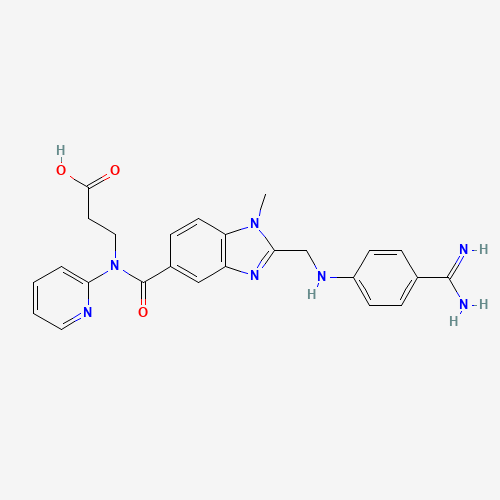| Pharmaceutical Information |
| Drug Name |
Dabigatran |
| Drug ID |
BADD_D00563 |
| Description |
Dabigatran is the active form of the orally bioavailable prodrug [dabigatran etexilate]. |
| Indications and Usage |
Not Available |
| Marketing Status |
approved; investigational |
| ATC Code |
B01AE07 |
| DrugBank ID |
DB14726
|
| KEGG ID |
D09707
|
| MeSH ID |
D000069604
|
| PubChem ID |
216210
|
| TTD Drug ID |
D0M7JT
|
| NDC Product Code |
51869-0030 |
| UNII |
I0VM4M70GC
|
| Synonyms |
Dabigatran | N-((2-(((4-(aminoiminomethyl)phenyl)amino)methyl)-1-methyl-1H-benzimidazol-5-yl)carbonyl)-N-2-pyridinyl-beta-alanine | BIBR 1048 | Pradaxa | Dabigatran Etexilate | Etexilate, Dabigatran | Dabigatran Etexilate Mesylate | Etexilate Mesylate, Dabigatran | Mesylate, Dabigatran Etexilate |
|
| Chemical Information |
| Molecular Formula |
C25H25N7O3 |
| CAS Registry Number |
211914-51-1 |
| SMILES |
CN1C2=C(C=C(C=C2)C(=O)N(CCC(=O)O)C3=CC=CC=N3)N=C1CNC4=CC=C(C=C4)C(=N)N |
| Chemical Structure |

|
|
| ADRs Induced by Drug |
|
|
*The priority for ADR severity classification is based on FAERS assessment, followed by the most severe level in CTCAE rating. If neither is available, it will be displayed as 'Not available'.
**The 'Not Available' level is hidden by default and can be restored by clicking on the legend twice..
|
|
|

